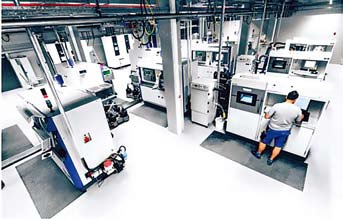
Nevertheless, this is a long way from meaning that the classical machine tool is going to be pensioned off.
Carl Fruth has meanwhile long since achieved his goal of “transferring competences in the field of multi-layer technologies into product manufacturing”: moreover, within the framework of a Technology Day featuring an in-house exhibition held in April 2017, FIT AG (Fruth Innovative Technologies) in the Upper Palatinate village of Lupburg, in addition to inaugurating a new office building also opened the “first additive factory”. The “FIT factory is even on an international comparison unique in terms of manufacturing capacity and automation technology, and is intended to serve as a template for further additive manufacturing facilities of the FIT Group,” to quote the firm’s founding father and Managing Board Chairman Carl Fruth. He is a pioneer of additive manufacturing – and a visionary for whom ten years ago it was already a certainty that multi-layer construction technology would in future be the norm in everyday production operations and the sales of milling machines or injection moulding machines would inexorably decline.
But that is still a long way from meaning that the days of the “mother of all machines (i.e. the traditional machine tool) are numbered. One of the impediments to the widespread adoption of additive technology in individualised mass production was described several years go by Carl Fruth himself as the “lack of production-suited manufacturing lines”. This has changed in the meantime. Carl Fruth puts it like this: “There are a large number of delicate seedlings: many of our customers would like to use additive technologies to manufacture replacements for existing components. But this is possible only in a very few cases. Usually, a new component has to be developed and very often the adjoining components of the system as well. Firstly, many companies are deterred by the outlay involved, and secondly, of course, you need specialised development competence for this new production technology.”
New designer engineers
When traditional design guidelines no longer apply, a new generation of design engineers is needed, keen to embrace function-driven thinking. According to Carl Fruth, additive manufacturing means “that in the design phase not only the geometry, but also the material properties and the component costs are essentially specified in full. This complexity necessitates specialised training and experience. Moreover, up to now there is no software tool in existence that provides all the requisite functions. So firms have to work with different, complex software tools. Very often, information is lost in transitioning from one tool to another. When you need up to eight iterations for developing a component, the substantial outlay involved is obvious.”
˝The competences required, moreover, are possessed not by a single design engineer, but only by a team. In traditional companies, furthermore, the competences concerned are divided up among different departments - a situation exacerbated by squabbles about prerogatives and uncertainty. Innovative companies, however, also see this as an opportunity: “We support our customers in this process, and train them component by component to achieve maximised performance in AM design. That’s why we also call these products ADM – Additive Design and Manufacturing”.
When the talk turns to “additive manufacturing in an automated process chain” (something he used to refer to as the “Achilles’ heel!), Carl Fruth becomes veritably effusive: “This is my own particular hobbyhorse. We don’t have a digital specification of our products. This is why Industry 4.0 hasn’t taken off, and also why automation isn’t working properly either. When everything has to be automated and optimised by hand, then the traditional forms of mass production are – old hat!” Whether there’s a robot standing at the production line or a human employee turning the product, there are no fundamentally new approaches involved: “For as long as a drawing and thick ring binders of text are required for specifying a product, Industry 4.0 is never going to get off the ground. In this context, it’s immaterial whether there’s a PDF file for the specification involved – we’re talking here about machine-readable specifications and their fully automated implementation.” Some former weak points, by contrast, he adds, like the reproducibility of the processes, quality assurance in mass production, or dependable simulation methods, have been almost eliminated: “Everyone involved has understood the problem, and is working purposefully to sol
Author: Walter Frick
ADIDAS













